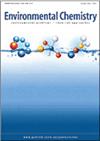Concentrations of CHCl3, C2HCl3, C2Cl4, CHBr3 and CHBr2Cl in the South Yellow Sea and the East China Sea during autumn
IF 2.3
4区 环境科学与生态学
Q3 CHEMISTRY, ANALYTICAL
引用次数: 1
Abstract
Environmental context Atmospheric trace gases called volatile halocarbons (VHCs) significantly contribute to ozone depletion and global warming. The oceans are a primary source of VHCs, and concentrations and fluxes of selected VHCs in the Yellow Sea and East China Sea were measured. These data, and the influence of marine environmental factors on these parameters, provide information which will permit the assessment of the marine contribution of VHC behaviour and impact. Abstract Concentrations of five volatile halocarbons (VHCs), that is, chloroform (CHCl3), trichloroethylene (C2HCl3), tetrachloroethylene (C2Cl4), bromoform (CHBr3) and chlorodibromomethane (CHBr2Cl), were measured in the South Yellow Sea (SYS) and East China Sea (ECS) during autumn in 2011. The average (min–max) concentrations of CHCl3, C2HCl3, C2Cl4, CHBr2Cl and CHBr3 in surface seawater were 63.91 (24.63–361.23), 28.46 (1.82–85.77), 21.04 (9.85–89.31), 20.92 (7.98–59.89) and 75.91 (0.04–537.04) pmol L−1 respectively. The five VHCs exhibited a point distribution in autumn with clearly defined patterns in certain areas. In the vertical profiles, the highest concentrations of VHCs generally appeared in the upper mixing layer. Different VHCs were correlated with different environmental parameters, such as temperature, salinity, chlorophyll a (Chl-a), nutrient levels and bacteria. These results revealed that the sources of these VHCs were influenced by the Yangtze River effluent and Kuroshio waters as well as the biogenic release. Diurnal bimodal cycles were obvious in the concentrations of the five VHCs in the ECS. In general, concentrations peaked around noon, likely owing to biological production and photochemical mechanisms, and a secondary peak occurred around midnight, possibly resulting from a combination of respiration, zooplankton feeding and tidal action. The estimated sea-to-air fluxes showed that the study area was a net source of the five VHCs in the atmosphere during the study period.南黄海和东海秋季CHCl3、C2HCl3、C2Cl4、CHBr3和CHBr2Cl浓度
大气中被称为挥发性卤代烃(vhc)的微量气体对臭氧消耗和全球变暖有重大影响。海洋是vhc的主要来源,本文测量了黄海和东海部分vhc的浓度和通量。这些数据以及海洋环境因素对这些参数的影响提供了信息,使人们能够评估甚强hc行为和影响对海洋的贡献。2011年秋季,对南黄海(SYS)和东海(ECS)海域的氯仿(CHCl3)、三氯乙烯(C2HCl3)、四氯乙烯(C2Cl4)、溴仿(CHBr3)和氯二溴甲烷(CHBr2Cl) 5种挥发性卤代烃(vhc)浓度进行了测定。表层海水中CHCl3、C2HCl3、C2Cl4、CHBr2Cl和CHBr3的平均浓度(min-max)分别为63.91(24.63 ~ 361.23)、28.46(1.82 ~ 85.77)、21.04(9.85 ~ 89.31)、20.92(7.98 ~ 59.89)和75.91 (0.04 ~ 537.04)pmol L−1。5个高碳区在秋季呈点状分布,在某些地区格局明显。垂直剖面上,vhc浓度最高的区域一般出现在上层混合层。不同的vhc与不同的环境参数如温度、盐度、叶绿素a (Chl-a)、营养水平和细菌有关。结果表明,这些vhc的来源不仅受到长江污水和黑潮的影响,还受到生物源释放的影响。ECS中5种vhc的浓度呈明显的日双峰循环。一般来说,浓度在中午左右达到峰值,可能是由于生物生产和光化学机制,而第二个峰值发生在午夜左右,可能是由于呼吸作用、浮游动物摄食和潮汐作用的综合作用。估算的海气通量表明,在研究期间,研究区是大气中五种vhc的净来源。
本文章由计算机程序翻译,如有差异,请以英文原文为准。
求助全文
约1分钟内获得全文
求助全文
来源期刊

Environmental Chemistry
环境科学-分析化学
CiteScore
4.50
自引率
0.00%
发文量
0
审稿时长
2.7 months
期刊介绍:
Environmental Chemistry publishes manuscripts addressing the chemistry of the environment (air, water, earth, and biota), including the behaviour and impacts of contaminants and other anthropogenic disturbances. The scope encompasses atmospheric chemistry, geochemistry and biogeochemistry, climate change, marine and freshwater chemistry, polar chemistry, fire chemistry, soil and sediment chemistry, and chemical aspects of ecotoxicology. Papers that take an interdisciplinary approach, while advancing our understanding of the linkages between chemistry and physical or biological processes, are particularly encouraged.
While focusing on the publication of important original research and timely reviews, the journal also publishes essays and opinion pieces on issues of importance to environmental scientists, such as policy and funding.
Papers should be written in a style that is accessible to those outside the field, as the readership will include - in addition to chemists - biologists, toxicologists, soil scientists, and workers from government and industrial institutions. All manuscripts are rigorously peer-reviewed and professionally copy-edited.
Environmental Chemistry is published with the endorsement of the Commonwealth Scientific and Industrial Research Organisation (CSIRO) and the Australian Academy of Science.
 求助内容:
求助内容: 应助结果提醒方式:
应助结果提醒方式:


